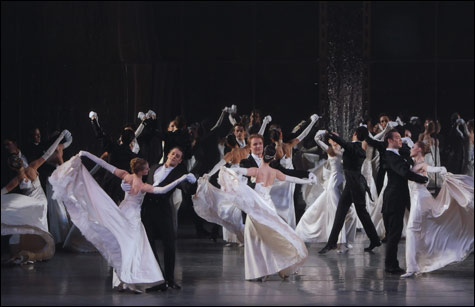
VIENNA WALTZES: The orchestra and the dancers have to surge into the Rosenkavalier beat, and they did. |
A day at New York City Ballet that starts with a matinee of Coppélia and ends with a Balanchine evening might seem to offer merely the contrast between classic and modern, old and new. But the three Balanchine pieces that NYCB presented last Saturday — Chaconne, The Four Temperaments, and Vienna Waltzes — reflected Coppélia the way the dizzily mirroring ballroom reflects the last, Rosenkavalier segment of Vienna Waltzes. The eternal verities of boy-meets-girl multiply like Ginger in Shall We Dance; they distort, diffract, devolve. You wonder whether Coppélia can put them back together again.
Based on the E.T.A. Hoffmann story "The Sandman" (also the inspiration for the Olympia segment of Offenbach's Tales of Hoffmann) and premiered in Paris in 1870, Coppélia gives us the eternal verities of 19th-century ballet: a sweet, small town in Central Europe, a boy and a girl in love, and another girl. (It's almost never another boy — probably because the ballet master had enough trouble coming up with the first one.) Like James in La Sylphide and Albrecht in Giselle and Siegfried in Swan Lake, Frantz (sometimes even one boy was too difficult: the character was originally danced en travestie) is pledged to the Eternal Feminine, so when he sees the doll-beautiful Coppélia sitting in a window, he forgets about Swanilda, even though Coppélia barely blows him a kiss.

That's because, of course, Coppélia is a doll. In the second act, she even dances — a curious Swanilda has sneaked into Dr. Coppélius's workshop, and when the dollmaker catches her, she pretends she's Coppélia come to life. You'd think seeing his Dream Girl dance and then discovering it's his Real Girl would be a lesson for Frantz, but he spends the entire act out cold, Coppélius having slipped him a mickey in the arcane hope of transferring Frantz's spirit into Coppélia. In the end, he realizes the truth about Coppélia, he's reconciled to Swanilda, and we get the traditional final act of marriage and amusements. But is there another Coppélia in Frantz's future?
One reason Frantz has so much time to flirt is that he hardly dances in the first two acts. It's Swanilda's ballet (all the more telling that the title is Coppélia), and at Saturday's matinee Sterling Hyltin was a teasing heroine, accomplished in little-girl dudgeon, doll-like in a way that poked fun at Frantz's infatuation with an actual doll; in the second act, she made the transition clear from dancing like a doll to (after Coppélius "gives" her Frantz's heart) dancing like a woman. She's precise without being punchy, and in her arduous third-act pas de deux with Frantz, she was rock-solid and coulante on pointe; the moments when Gonzalo Garcia turned her around and into arabesque seemed to last forever. Garcia (who was Boston Ballet principal Lorna Feijóo's partner when she danced Ballo della Regina with NYCB in 2004 and guested as Boston Ballet principal Erica Cornejo's Basilio in the company's 2006 Don Quixote) was a boyish and endearing cartoon of a Frantz in the first act and a measured success in his dancing in the third, with clear aerial beats, a quartet of full double tours, and firm support for Hyltin. The crowd pleaser, however, was the Waltz of the Hours troupe, 24 budding Swanildas from the School of American Ballet.
The setting of NYCB's production is a puzzle. The program identifies it as "a village square in Galicia" (i.e., northwest Spain). But with its hues of rose, ocher, orange, celadon, and aqua, the first act conjures Provence as painted by Cézanne, and the banners are in French: "Demain la fête de carillon" and "Les noces de village." The "Burgomaster" wears an oversized Napoleonic hat; some of the ethnic costuming looks Balkan. Although the orchestra, conducted by Maurice Kaplow, started on an unhappy note with wobbly horns, the mazurka and the csárdás had rhythmic point and dancelike pacing.
Chaconne, which opens amid the clouds of Mount Parnassus, goes back to 1936, when Balanchine staged an innovative (and short-lived — just two performances) version of Gluck's Orfeo ed Euridice for the Metropolitan Opera, with the dancers on stage and the singers in the pit. In 1963, Balanchine did the choreography for the Hamburg State Opera production of Gluck's work, and that's the basis of Chaconne, which premiered in 1976 as a vehicle for Suzanne Farrell and Peter Martins.
Writing about that premiere, Arlene Croce described the opening duet as "less a prologue to the ballet than a puzzling preliminary. What follows is completely different in style — a rococo divertissement with entries for the corps de ballet and demi-soloists." This "prologue" became perhaps less puzzling when Balanchine added a ceremonial section for nine women — the Muses? — in cinnamon chiffon, their hair unbound. That duet for the principal couple then becomes more dream than dance, the woman looking as if she were about to take flight, her hair also flowing. In the ballet proper, they bring their art down to Earth. There's a pas de trois, a pas de deux, and a pas de cinq for demi-soloists. (On the 1978 Dance in America performance that's part of the VHS/DVD Balanchine Library, these divertissements — about a quarter of the ballet — are omitted.) The principal couple enter, the woman's hair now up, and execute a minuet and a gavotte (the latter with three solo variations for each) before joining the ensemble for the concluding celebratory chaconne.